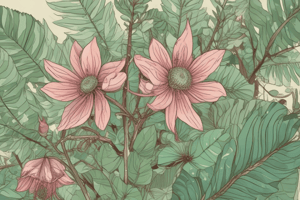Podcast
Questions and Answers
What are the four characteristics that all plants share?
What are the four characteristics that all plants share?
- Plants reproduce with spores and sex cells (correct)
- Plants make their own food (correct)
- Plants have a cuticle (correct)
- Plant cells have a cell wall (correct)
Define a plant 'cuticle'.
Define a plant 'cuticle'.
A waxy layer that coats the stems, leaves, and other parts of the plant that are exposed to air.
What is the role of the plant's cuticle?
What is the role of the plant's cuticle?
To keep it from drying out.
What is the role of the plant's cell walls?
What is the role of the plant's cell walls?
What is thought to be the ancient ancestor of all plants?
What is thought to be the ancient ancestor of all plants?
What evidence supports the theory that all plants came from green algae? (Select all that apply)
What evidence supports the theory that all plants came from green algae? (Select all that apply)
What are the two main groups of plants?
What are the two main groups of plants?
What are 'non-vascular' plants?
What are 'non-vascular' plants?
What is the typical size of a 'non-vascular' plant?
What is the typical size of a 'non-vascular' plant?
What are two examples of a 'non-vascular' plant?
What are two examples of a 'non-vascular' plant?
What are 'vascular' plants?
What are 'vascular' plants?
What are the 'tissues' in vascular plants called?
What are the 'tissues' in vascular plants called?
What two groups are vascular plants divided into?
What two groups are vascular plants divided into?
What are some examples of non-seeded vascular plants?
What are some examples of non-seeded vascular plants?
What are the two types of 'seeded' vascular plants?
What are the two types of 'seeded' vascular plants?
Flashcards are hidden until you start studying
Study Notes
Characteristics of Plants
- All plants share four common characteristics:
- They produce their own food through photosynthesis.
- They possess a protective waxy cuticle.
- Their cells have rigid cell walls for structure.
- Reproduction occurs via spores and sex cells.
Plant Cuticle
- A plant cuticle is a waxy layer that covers aerial parts of the plant, such as stems and leaves.
- The primary function of the cuticle is to prevent moisture loss, thereby keeping the plant hydrated.
Plant Cell Walls
- Cell walls provide structural support and protection, contributing to the plant's overall integrity.
Evolutionary Ancestor
- Green algae is considered the ancient ancestor of all plants, indicating a close evolutionary relationship.
Evidence Supporting Plant-Algal Connection
- Similar coloration between plants and green algae.
- Both contain chlorophyll, essential for photosynthesis.
- Similarity in cell wall composition.
- Energy storage in both forms takes place as starch.
- A common life cycle characterized by a two-part system.
Plant Groups
- Plants are categorized into two main groups:
- Non-vascular plants, lacking specialized tissues for transport.
- Vascular plants, featuring systems that efficiently deliver nutrients and water.
Non-Vascular Plants
- Non-vascular plants do not possess transporting pipes and rely on diffusion and osmosis for movement of materials.
- They are typically small in size.
- Examples include moss and liverwort.
Vascular Plants
- Vascular plants have specialized tissues that distribute water and nutrients throughout the plant.
- These tissues allow them to grow larger and more complex due to improved transport capabilities.
Vascular Plant Tissues
- The conducting tissues in vascular plants are known as vascular tissues.
Vascular Plant Categories
- Vascular plants are further divided into:
- Seed-producing plants.
- Non-seed-producing plants.
Non-Seeded Vascular Plants
- Examples of non-seeded vascular plants include ferns, horsetails, and club moss.
Seeded Vascular Plants
- Seeded vascular plants are classified into two groups:
- Angiosperms (flowering plants).
- Gymnosperms (non-flowering plants).
Studying That Suits You
Use AI to generate personalized quizzes and flashcards to suit your learning preferences.




